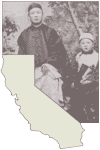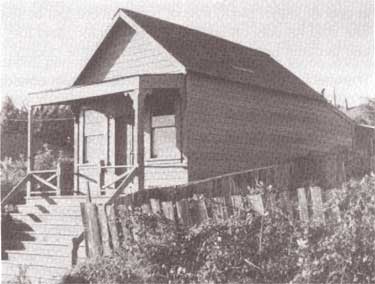![]()

Five Views: An Ethnic Historic Site Survey for California
MENU
Introduction
Early Contacts
1850s
1860s
1870s
1880s
1890s
1900s
Historic Sites
Selected References

A History of Chinese Americans in California:
HISTORIC SITES
Mo Dai Miu (Temple of Kuan Kung)
Mendocino, Mendocino County
The Temple of Kuan Kung is located in the town of Mendocino. This simple, rectangular building is sheathed in shiplap redwood siding, with a gable roof. It is painted red with green trim. Steep stairs lead to a porch extending the length of the front facade, which has a central door with a large window on either side. Over the door is a red sign, giving the name of the temple in gold letters.
The interior in divided into two rooms, an altar room in front and a priest's room in back. The altar room is simply furnished, with two altar tables against the back wall, one unpainted wooden bench on either side of the room, and a stove for burning paper offerings near the door. On the back wall is a painting of Kuan Kung. The altar tables hold incense burners, candle holders, vases, containers of fortune-telling sticks, dishes, and offerings.
The building is situated on a hill overlooking the Pacific Ocean and the site of Mendocino's early Chinese American community.
The Mo Dai Miu (or Temple of Kuan Kung) in Mendocino is a rare structure, for it appears to be one of only a few remaining buildings relating to the early Chinese pioneers. There is no mention of Chinese Americans in the 1880s History of Mendocino County, even though there were 346 of them in the county according to the 1880 Census. Oral history accounts tell of many more Chinese in the lumber industry who were not recorded by the census.
This Taoist temple is still maintained in continuous worship by the great-grandchildren of one of its founders, Joe Lee (or Chong Sung). According to his descendants, Joe Lee set out from China in the 1850s in one of seven ships, five of which were lost at sea. The ship he was on landed in Mendocino, and Joe Lee became one of the early settlers in the county.
The site for the temple appears to have been chosen according to the Chinese rules of geomancy. It was placed on a hill overlooking the early Chinese American community, on the swampy headlands of Mendocino. The two large windows on the building's facade look out over the ocean the Chinese crossed. Thus, the picture of Kuan Kung faces the ocean. On the walls inside the temple are written thanks for a safe journey here, and prayers for a safe return.
Kuan Kung is sometimes known as the god of war, but this designation is misleading. Kuan Yu (later called Kuan Kung) was an actual person who lived in China during the Three Kingdoms Period, in the third century A.D. He was a military leader renowned for his courage, loyalty, and adherence to lofty ideals. He was even known to have sacrificed his personal success when that would have required him to compromise his principles. These qualities are the reasons that he was venerated after his death and became so popular among the early Cantonese who came to this country.
The Temple of Kuan Kung, listed as a California State Historical Landmark, is the last remaining Chinese house of worship on the north coast of California. Documented history dates the structure to 1883, but oral history suggests that the temple was built in 1854.

Mo Dai Miu (Temple of Kuan Kung), Mendocino, Mendocino County
NEXT> Nevada City Chinese American Cemetery
Last Modified: Wed, Nov 17 2004 10:00:00 pm PDT
http://www.cr.nps.gov/history/online_books/5views/5views3h59.htm
![]()
 Top
Top